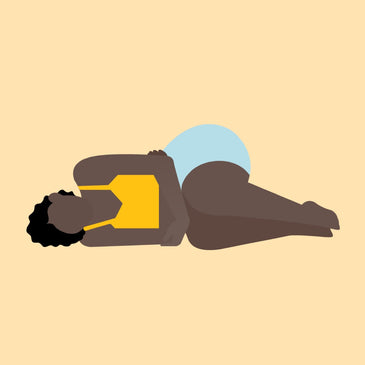Bodily does not provide medical advice, diagnosis, or treatment. The resources on our website are provided for informational purposes only. You should always consult with a healthcare professional regarding any medical diagnoses or treatment options.
Shop the Vaginal Birth Recovery Collection here.
What is it?
While it sounds unpleasant (or downright scary), tearing is actually a common birth injury that most women recover from quickly and without complication. Tearing is the term for lacerations to vaginal tissue during birth. While the surge of estrogen, elastin and relaxin prepare the vagina to become more elastic for labor and delivery, it is quite common for tearing to occur, most often when the baby’s head and shoulders are emerging from the vagina.
Tears can occur on the skin of the perineum, the region that connects the vagina and the rectum, and can range from small, superficial abrasions, which require no stitches at all (30% of vaginal births require no stitches) to mild tears, which require minimal stitches. More rarely, deeper muscular tears can occur, which require more repair.
How common is it?
Very common: 85% - 90% of first-time births result in vaginal tears. Rates of tearing are lower for subsequent births — where roughly 60% tear — as well as for those giving birth with midwives. Factors influencing the extent of tearing and type include:
- Delivery method including giving birth laying down (higher rates) versus upright (lower rates)
- Use of forceps and vacuum (more significant tearing)
- Speed of childbirth (prolonged second stage of labor has higher rates)
- Fetal size (larger weights have higher rates)
- Where the delivery takes place geographically
- Cultural and local practices
How long does recovery last?
The length of recovery depends on the type of tear. There are four degrees of tears, with the vast majority being first- and second-degree minimal tears.
1st & 2nd Degree
Fast recovery and minor wounds; 94% of cases.
1st-degree tears
These are superficial wounds like abrasions or minor cuts that generally don’t require stitches, and heal quickly (in a few days to a week). This is defined as only involving the skin. Perineal pain and soreness, or stinging during urination, are the norm in recovery.
2nd-degree tears
Defined as involving some of the some of the tissue beyond just the very surface layer (i.e. skin and some muscle). This generally requires stitches, and healing time is one to three weeks. Recovery includes pain or stinging during urination.
3rd & 4th Degree
Longer and more complicated recovery, with potentially significant wounds and active recovery required; 6% of cases.
A recent study showed that third- and fourth-degree tears happened in 5.9% of births for first-time mothers, and the likelihood of severe tearing increased fivefold — from 1.3% to 7.2% — if previous tearing had occurred.
3rd-degree tears
Third-degree tears are defined as wounds that extend from the vagina to involve the muscular tissue that surrounds the anus. These tears can be repaired immediately after birth with anesthesia in a separate operating room.
These more serious tears usually heal without complications, though in rare occasions they can lead to lingering issues with bladder, bowel and sexual function. Soreness at the repair site, painful sexual intercourse, fecal incontinence and uncomfortable bowel movements are all reasons to contact your care provider. Recovery time is one month or longer.
4th-degree tears
Fourth-degree tears involve the anal sphincter as well as the mucous membrane that lines the rectum, and they are the most severe. They are generally repaired after birth with anesthesia in a separate operating room, and can take several months to fully heal.
What can be done about it?
Here are some remedies that provide temporary relief and may speed healing:
Pain relievers
What
Ibuprofen and/or acetaminophen
How
As directed by an OB-GYN or midwife, who may suggest that you “pair” them, or alternate between them, since they target different pain receptors.
Why
To relieve pain. These are considered safe if you are breastfeeding.
Peri wash bottle
What
A perineal wash bottle is a handheld water bottle with a spray nozzle.
How
Spray a gentle stream of water over the vaginal area while peeing to dilute the stinging effects of urine on healing areas. It also helps to avoid using toilet paper.
Why
A peri bottle helps to keep wounds clean, reduces inflammation and prevents abrasions. Adding witch hazel, soothing oils or peri sprays to the peri bottle water may also provide pain relief.
Where can you find it
Numbing Spray
What
Perineal sprays. There are all-natural formulations containing witch hazel and cooling oils like Peri Spray, and over the counter cooling agents like Dermoplast that use benzocaine and menthol.
How
After urinating, sitting for an extended period of time, or otherwise when seeking soothing aid, spray the numbing agent of your choice on the perineal area to provide temporary cooling or numbing relief.
Why
Numbing or cooling spray can provide temporary pain relief and potentially other benefits (such as anti-inflammatory, anti-microbial, etc), depending on the formulation.
Sitz bath
What
A sitz bath is a shallow tub that sits on top of the toilet.
How
Soak the vulva, vagina and buttocks for 10–20 minutes, one to two times per day in warm water.
Why
Sitz baths can reduce pain and swelling, as well as keep the perineum clean. There is some evidence that adding Epsom salts, lavender oil or olive oil to the water can promote healing. Other ingredients such as calendula also have soothing antimicrobial and anti-inflammatory effects.
Cold packs
What
Ice packs or cold gel packs
How
They can be worn inside your mesh underwear immediately post-birth.
Why
Cold packs can provide temporary numbing for pain relief.
Where can you find it
While you may have a soft version already from carry cooler, you can find lots of gel bead ice packs at your preferred big box retailer.
Witch hazel
What
Wipes or frozen maxi pads
How
Apply (alcohol-free) witch hazel wipes or soak maxi pads with witch hazel and freeze. Place the frozen pad on top of a dry maternity pad in your underwear to absorb any bleeding and leakage. (Pro tip: Make a bunch of these so they’re ready to go.)
Why
The chemical compounds found in witch hazel (tannins) have vasoconstrictors, which have been shown to be as effective as anesthetic sprays and other pain relievers.
Where can you find it
You can find witch hazel at pharmacies and big box retailers.
Donut-shaped cushions
What
A device to prevent sitting on hard surfaces.
How
Sit instead on a soft pillow or doughnut-shaped cushion.
Why
Hard surfaces compress wounds and inhibit blood flow to healing areas.
Where can you find it
We tested the leading foam and inflatable cushions and found that the benefit from the portability of an inflatable cushion outweighed the benefit of the slightly cushier feel of the foam cushion (making it possible to bring to the hospital or birth center to make the car ride home more comfortable, among other examples).
Stool softeners
What
Magnesium citrate, prune juice, Colace (docusate sodium), Miralax (polyethylene glycol)
How
As directed by an OB-GYN or midwife
Why
Stool softeners or laxatives can help avoid constipation and straining that can be painful and irritating to perineal or vaginal areas.
Where can you find it
This postpartum essential can be found at any pharmacy, and is included in every one of our recovery kits (C-Kit, Care For Birth Box, etc)
What can be done to prevent it?
Throughout your pregnancy and labor, there are measures you can take to prepare the perineum and vagina for birth and minimize tearing, though there is no guarantee that they will be effective.
Prenatal perineal massage
Prenatal perineal massage, performed at the end of the third trimester, can stretch the perineum and vaginal tissue to prepare it for birth.
Warm compress
One way to do this is by applying warm compresses to the perineum continuously during and between contractions. This is typically done by your doctor or midwife.
Body positioning during labor
During labor, positioning your body in a non-flat position — onto all fours, using a squat bar or laying on your side — can also reduce the probability of tearing or lessen the severity of injury.
Minimizing certain factors
Factors that can contribute to lacerations or tears at birth include prolonged push periods, deliveries assisted by forceps or a vacuum, a baby in the posterior position (“back labor”) or presenting with shoulder dystocia, or a baby with a higher birth weight (if a baby is over 8.8 pounds, tearing is 2.27 times more likely).
Controlled pushing
Controlled pushing, especially during the crowning phase of birth, can help to stretch the perineal tissue gently and help to minimize tearing. Your midwife or doctor may offer strategic coaching during this phase to help minimize tearing.
When should I be worried?
If the pain at the site of tearing or stitches is severe, persistent or increases, and if you have an elevated temperature over 100.4, it’s important to talk to a doctor, because those could be signs of infection. If tearing is extensive, talking to your doctor or midwife is often the first step, since they can refer patients to specialists, like urogynecologists, colorectal surgeons or pelvic floor therapists.
Shop the Vaginal Birth Recovery Collection here.




